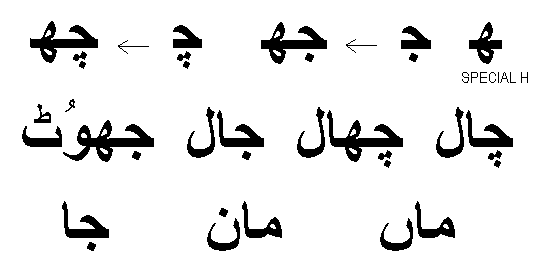Lesson 7

Lets look at the second line of the Urdu alphabet. These letters are J , Ch , H and Kh -read as Jeem , Cheem , Hae and Khae.

See if you can read the follwing words . It is not important that you get them right the first time but you should be able to reread them easily. Masculine words end with Aa eg
Dada ( grandfather) while feminine words end with i - Dadi (grandmother). Another example is
Chacha (uncle) and Chachi ( Aunt). In the figure below the first line has English words. The second and third one have one of the most beautiful buildings in the world and Urdu words.
Here are the answers

Revise your vowel marks to see if you agree with the answers above. Note the sound doubler in Bachcha - on Line 3.
The special H can be used for J and Ch to give the deeper JH and CHH sounds as for example in the Udu words Jhanda -flag and Chhatri - Umbrella. In the figure below see if you can read the words in Urdu on the second line and the sentence on the third line.
Here is the answer.
 .
.
Note that the N in the word mother ( Maa'n)is a nasal N and is not pronounced except from the back of the throat- the tongue stays down flat. That is why it is marked with an apostrophe. The N in the word Maan is pronounced with the tongue on the teeth and has the dot in it.
It is better to start reading childrens books and build up a vocabulary before reading Urdu newspapers. The reason is that often there are no spaces between the words in the newspapers. It is not necessary for experienced readers as they can tell instantly from the final form of a letter where the word ends but the lack of space before the next word can be very confusing for beginners. Another reason is that sometimes the space below a letter gets crowded and often a vowel mark will be left out and that can make it very difficult to read the words as well.
Remember to reread all the previous lessons before moving on to the new one. It should take no more than fifteen minutes each time and you will find the learning experience a lot smoother .
Lesson 7

